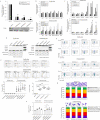Down-regulation of the transcriptional repressor ZNF802 (JAZF1) reactivates fetal hemoglobin in β0-thalassemia/HbE
- PMID: 35322124
- PMCID: PMC8943019
- DOI: 10.1038/s41598-022-08920-8
Down-regulation of the transcriptional repressor ZNF802 (JAZF1) reactivates fetal hemoglobin in β0-thalassemia/HbE
Erratum in
-
Author Correction: Down-regulation of the transcriptional repressor ZNF802 (JAZF1) reactivates fetal hemoglobin in β0-thalassemia/HbE.Sci Rep. 2022 Apr 13;12(1):6161. doi: 10.1038/s41598-022-10541-0. Sci Rep. 2022. PMID: 35418591 Free PMC article. No abstract available.
Abstract
Reactivating of fetal hemoglobin (HbF; α2γ2) can ameliorate the severity of β-thalassemia disease by compensating for adult hemoglobin deficiency in patients. Previously, microarray analysis revealed that zinc finger protein (ZNF)802 (also known as Juxta-posed with another zinc finger gene-1 (JAZF1)) was upregulated in human erythroblasts derived from adult peripheral blood compared with fetal liver-derived cells, implying a potential role as a HbF repressor. However, deficiency in ZNF802 induced by lentiviral shRNA in β0-thalassemia/hemoglobinE erythroblasts had no effect on erythroblast proliferation and differentiation. Remarkably, the induction of HBG expression was observed at the transcriptional and translational levels resulting in an increase of HbF to 35.0 ± 3.5%. Interestingly, the embryonic globin transcripts were also upregulated but the translation of embryonic globin was not detected. These results suggest ZNF802 might be a transcriptional repressor of the γ-globin gene in adult erythroid cells.
© 2022. The Author(s).
Conflict of interest statement
The authors declare no competing interests.
Figures


Similar articles
-
Disrupting ZBTB7A or BCL11A binding sites reactivates fetal hemoglobin in erythroblasts from healthy and β0-thalassemia/HbE individuals.Sci Rep. 2025 Jul 15;15(1):25580. doi: 10.1038/s41598-025-10791-8. Sci Rep. 2025. PMID: 40665149 Free PMC article.
-
SIRT1 activates the expression of fetal hemoglobin genes.Am J Hematol. 2017 Nov;92(11):1177-1186. doi: 10.1002/ajh.24879. Epub 2017 Aug 28. Am J Hematol. 2017. PMID: 28776729 Free PMC article.
-
Epigenetic inactivation of ERF reactivates γ-globin expression in β-thalassemia.Am J Hum Genet. 2021 Apr 1;108(4):709-721. doi: 10.1016/j.ajhg.2021.03.005. Epub 2021 Mar 17. Am J Hum Genet. 2021. PMID: 33735615 Free PMC article.
-
Transcriptional Repressor BCL11A in Erythroid Cells.Adv Exp Med Biol. 2024;1459:199-215. doi: 10.1007/978-3-031-62731-6_9. Adv Exp Med Biol. 2024. PMID: 39017845 Review.
-
C2H2 Zinc Finger Transcription Factors Associated with Hemoglobinopathies.J Mol Biol. 2024 Apr 1;436(7):168343. doi: 10.1016/j.jmb.2023.168343. Epub 2023 Nov 2. J Mol Biol. 2024. PMID: 37924864 Free PMC article. Review.
Cited by
-
Effects of Mithramycin on BCL11A Gene Expression and on the Interaction of the BCL11A Transcriptional Complex to γ-Globin Gene Promoter Sequences.Genes (Basel). 2023 Oct 11;14(10):1927. doi: 10.3390/genes14101927. Genes (Basel). 2023. PMID: 37895276 Free PMC article.
-
FLT1 and other candidate fetal haemoglobin modifying loci in sickle cell disease in African ancestries.Nat Commun. 2025 Mar 1;16(1):2092. doi: 10.1038/s41467-025-57413-5. Nat Commun. 2025. PMID: 40025045 Free PMC article.
-
Disrupting ZBTB7A or BCL11A binding sites reactivates fetal hemoglobin in erythroblasts from healthy and β0-thalassemia/HbE individuals.Sci Rep. 2025 Jul 15;15(1):25580. doi: 10.1038/s41598-025-10791-8. Sci Rep. 2025. PMID: 40665149 Free PMC article.
-
A cellular reporter system to evaluate endogenous fetal hemoglobin induction and screen for therapeutic compounds.Hemasphere. 2024 Aug 6;8(8):e139. doi: 10.1002/hem3.139. eCollection 2024 Aug. Hemasphere. 2024. PMID: 39108322 Free PMC article.
-
Exploring Novel Strategies to Alleviate Symptoms of β-Globinopathies: Examining the Potential Role of Embryonic ε-globin Induction.Transfus Med Rev. 2024 Oct;38(4):150861. doi: 10.1016/j.tmrv.2024.150861. Epub 2024 Oct 18. Transfus Med Rev. 2024. PMID: 39549502 Review.
References
-
- Somervaille T. Disorders of hemoglobin: genetics, pathophysiology, and clinical management. J. R. Soc. Med. 2001;94:602–603. doi: 10.1177/014107680109401119. - DOI
-
- Cui S, Kolodziej KE, Obara N, Amaral-Psarris A, Demmers J, Shi L, Engel JD, Grosveld F, Strouboulis J, Tanabe O. Nuclear receptors TR2 and TR4 recruit multiple epigenetic transcriptional corepressors that associate specifically with the embryonic β-type globin promoters in differentiated adult erythroid cells. Mol. Cell. Biol. 2011;31:3298–3311. doi: 10.1128/MCB.05310-11. - DOI - PMC - PubMed
MeSH terms
Substances
LinkOut - more resources
Full Text Sources
Medical
Molecular Biology Databases
Research Materials

